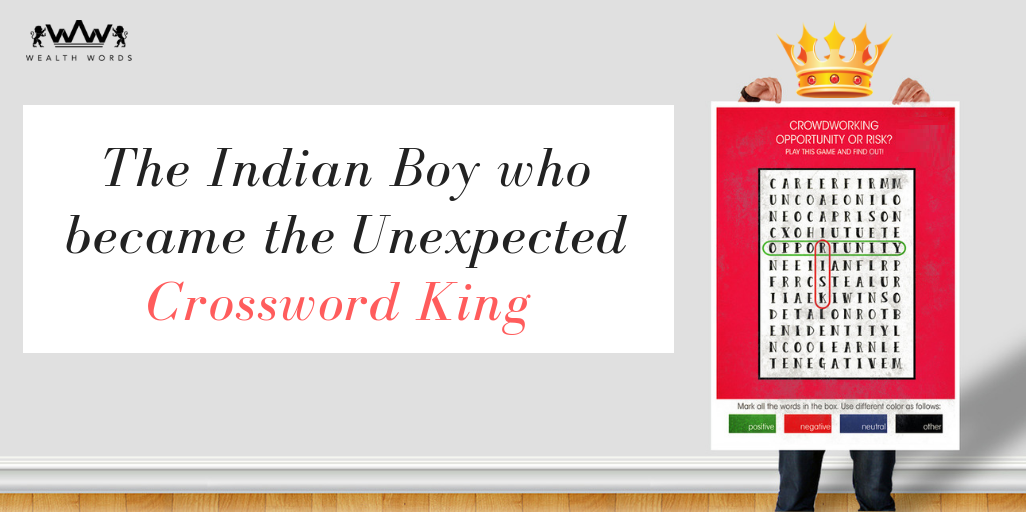Mangesh Ghogre is a name that almost every crossword enthusiast knows and admire. An esteemed crossword king from India, he is the only non-American to have his puzzles published in American newspapers. So, how did he become the crossword contractor for the New York Times, Los Angeles Times, and the Wall Street Journal? How did he become one of the most recognized crossword experts in America, India, and all around the world? Let’s hear his story!

His first encounter to the world of crosswords
Ghogre grew up outside Mumbai as an average student. He had no interest in words; no family history of success in this genre. His parents couldn’t even speak English. Makes you wonder how such an average student could turn the crossword world on its axis, doesn’t it? After studying science in his high school, he joined a renowned engineering college in Mumbai. This is where his story took a turn.
He joined Veermata Jijabai Technological Institute in 1997. For the first time, he saw how competitive and ambitious the environment was. Everyone wanted to go and study in the US. They were preparing for GRE and GMAT and more. While referring to his time in college, Ghogre says, “Everyone is walking around with Barron’s word list” (A famous study material).
He decided to study for GMAT and that is how he first encountered and took up crossword puzzles. A couple of other aspiring students would meet up and huddle at breakfast to solve the crossword puzzle printed in the Times of India. The puzzles were normally reprinted from the famous Los Angeles Times and had the classic black and white grids and clues all over. He, along with others, decided to take up the task to solve the puzzles so they could enhance their vocabulary. This is when he started his true journey to master the art of crossword puzzles. The path was difficult and filled with hurdles, but Ghogre kept putting in his effort to reach the position he is in today.
His struggles to grasp American crossword
As the puzzles were taken from a foreign country, it was filled with foreign concepts and unfamiliar words. The crossword puzzles were created for the US audience, based on their society and culture. Will Shortz, a legendary crossword editor at The New York Times says,” It is difficult for a non-American to make or even solve American crosswords because they’re so full of American Culture”. “You would have to understand American life, society, and English the way Americans speak it in order to master our puzzles”, he said.
So, how could this group solve those problems? They couldn’t, well, not all of them. Within just a month, the group thinned and everyone had stopped trying, except Ghogre. If you think Ghogre could solve the puzzles easily, you wouldn’t be more wrong. He was just as hopeless but the one thing he did have, was determination. Despite all the troubles, he kept on going.
After six months of regular practice, all he could do was fill the S’s. He understood that some points had plurals involved but still couldn’t understand the entire concept. More time went by and he continued his effort. Soon he was able to fill in the simple answers, identify the capitals, understand questions related to currencies, and more.
But the harder clues were still a problem. Every other clue talked about something that he has never even heard before. Who was Ares? Where is Lake Eyre? What on earth is a coati? Such topics were beyond his comprehension. These obscure and vowel-heavy words were devoted solely to American puzzle lovers which Ghogre was not.
But the unknown words did not discourage him. He learned about the pop culture, American politics, geography, biblical references, and much more to understand the clues. Instead of losing interest or admitting defeat, Ghogre became more determined than ever to master this art. He diligently worked on the vast vocabulary that the crossword was demanding. He composed lists, memorized answers and built up his vocabulary, slowly and steadily. And it was after a year and a half that he finished his first crossword without any help.
While taking a crossword workshop at the age of 38, after he achieved success, Ghogre featured a picture of his first solved crossword puzzle. The picture was filled with dense scribbles, notes in blue and black ink, decoded clues, and more. Every empty space was filled with some or other information. He had a section of planets in one part of the paper, animals in a different part, and some biblical references in the other. This showed his dedication and commitment towards the game.
His Achievements
Ghogre was able to achieve a substantial GMAT score but he ended up not using it. After completing his management degree from Mumbai in 2004, he started working in a bank. Today he is an investment banker by profession but his success in the world of crosswords is still unparalleled.
Even after getting a job at a well-known bank, he never lost his interest in puzzles. He continued to solve them and eventually started designing his own crosswords. He did have to face a string of rejections initially until he fine-tuned his art. Ghogre says, “It’s like classical dance. Very few do it, and it takes years to master”.
History was created when the Los Angeles Times accepted his first puzzle on March 9, 2010. He was the first ever as well as the only non-American whose crossword was published in an American newspaper. After that, he was also published in the New York Times, the Wall Street Journal, numerous other newspapers across the world. Ghogre’s crossword also found itself being featured in books like Games and World of Puzzles.
Ghogre never even set foot in the United States until he was invited to judge the annual crossword tournament of 2012. It is in this crossword tournament that he met Brenden Emmett Quigley, another renowned American puzzler. A collaboration was proposed and they finally created an Independence Day-themed crossword that was published in The New York Times on the Fourth of July. It is one of his greatest triumphs to date.
He has become a renowned personality in the Indian crossword community as well. Some of his crossword puzzles were displayed at the Kala Ghoda Arts Festival in Mumbai. Ghogre also hosted a crossword workshop at the American consulate to promote and enhance the popularity of crosswords in India. Despite the fact that a very few men and even few women attended the workshop, Ghogre still dreams to popularize the crossword culture and make it more prominent.
